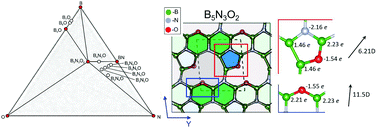Novel two-dimensional boron oxynitride predicted using the USPEX evolutionary algorithm†
Abstract
Oxidation is a unique process that significantly changes the structure and properties of a material. Doping of h-BN by oxygen is a hot topic in material science leading to the possibility of synthesis of novel 2D structures with customized electronic properties. It is still unclear how the atomic structure changes in the presence of external atoms during the oxidation of h-BN. We predict novel two-dimensional (2D) arrangements of boron oxynitride using the evolutionary algorithm of crystal structure prediction USPEX. All considered structures demonstrate semiconducting properties with a reduced bandgap compared with h-BN. Both molecular dynamics and phonon calculations show the dynamical stability of the new 2D B5N3O2 phase, and our calculations demonstrate that it can form a bulk layered structure with an interlayer distance larger than that of pure h-BN. The optical characterization shows a redshift of the absorption spectrum compared with pure h-BN. Incorporation of oxygen into the structure of 2D BN during synthesis or oxidation can dramatically change the covalent network of h-BN while preserving its two-dimensionality and flatness, following the presence of local dipole moments which could improve the piezoelectric properties.

- This article is part of the themed collection: 2021 PCCP HOT Articles


 Please wait while we load your content...
Please wait while we load your content...